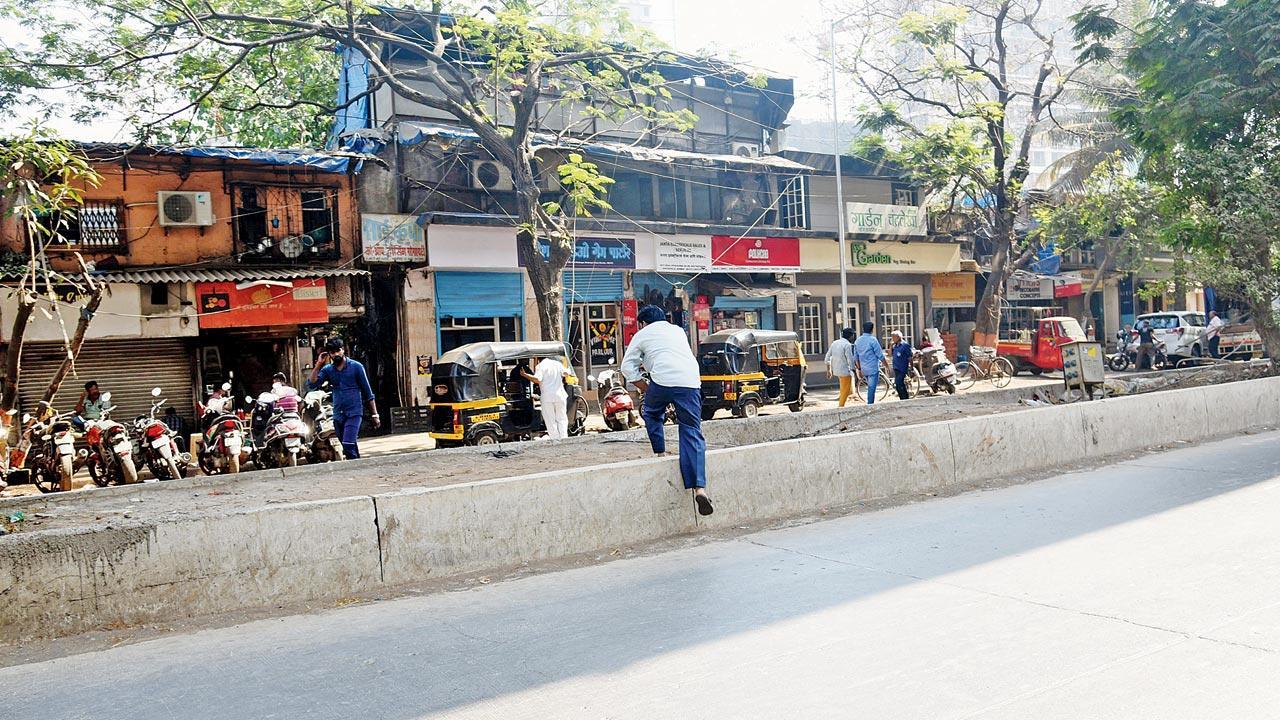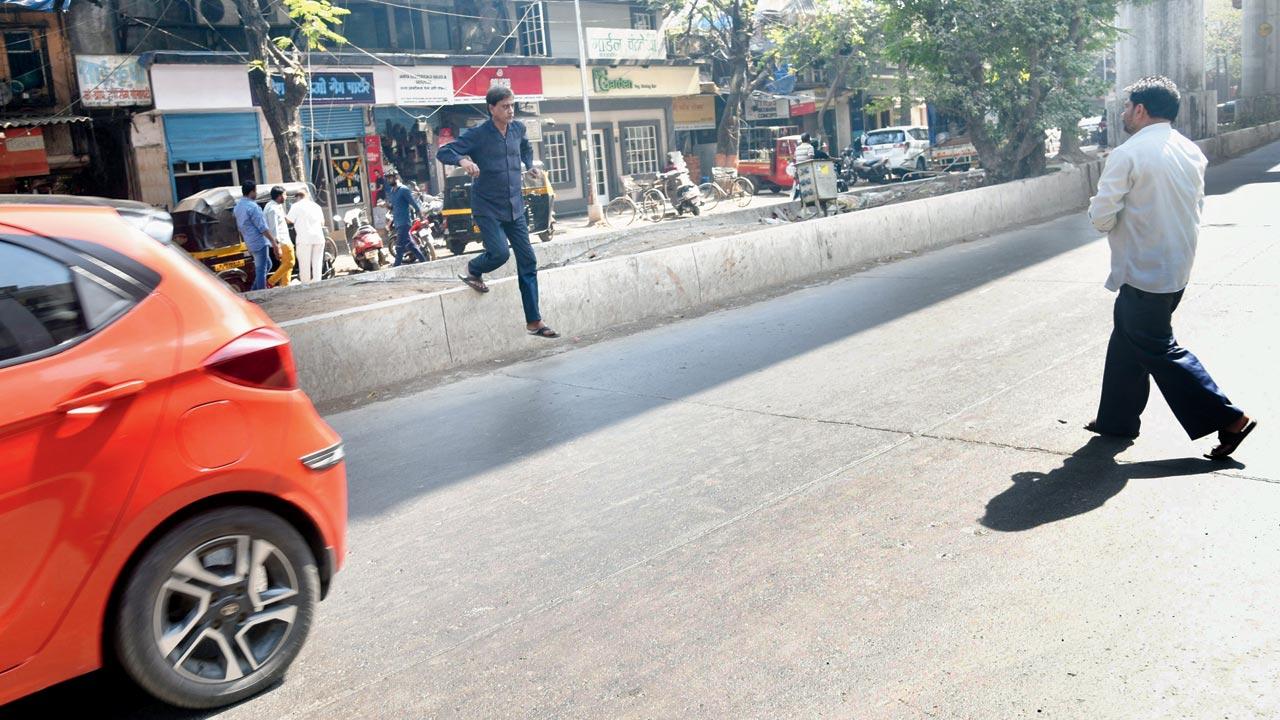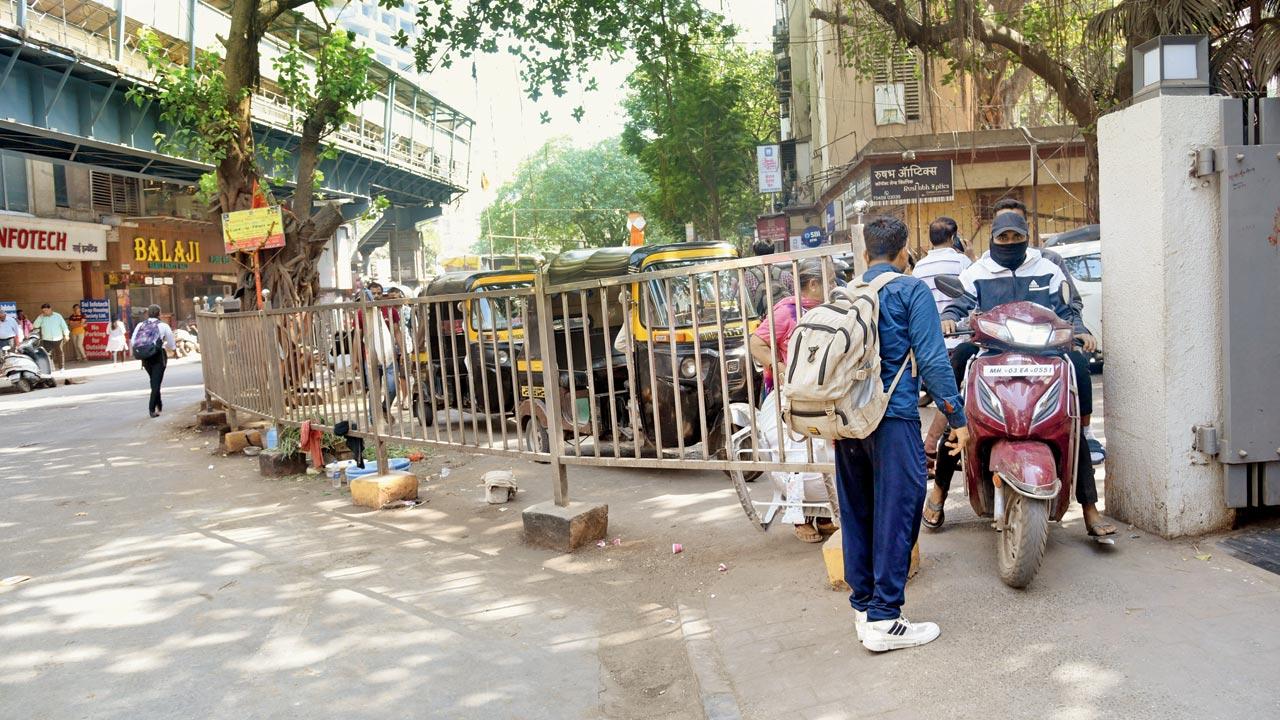Experts suggest reducing distance between gaps in dividers, marking the crossings and having speed breakers to slow down traffic

A long stretch of 90 Feet Road in Siddhivinayak Mandir does not have pedestrian crossing. Pic/Sameer Markande
As citizens have objected to the raised dividers, mid-day, in the third and final part of the series, speaks to experts to make pedestrians’ life better. They suggest that BMC reduce the distance between gaps in the dividers and make the crossings safe, with broad speed breakers and zebra markings, for both walkers and motorists.
ADVERTISEMENT
While the BMC is busy breaking apart dividers in perfectly fine condition, the one on Nanasaheb Dharmadhikari road in Kalanagar, Bandra East, is crumbling. There are cracks all along the 450-meter-long road and the paint has come off. Condition in eastern suburbs.
 A long stretch of 90 feet road outside Siddhivinayak Mandir has no gaps for pedestrian crossing, in Ghatkopar East. Pic/Sameer Markande
A long stretch of 90 feet road outside Siddhivinayak Mandir has no gaps for pedestrian crossing, in Ghatkopar East. Pic/Sameer Markande
After south Mumbai and
western suburbs, mid-day also took a test drive in the eastern suburbs. The divider on a stretch of 90 feet road, outside Siddhivinayak Mandir in Ghatkopar East, does not have a single pedestrian crossing. Residents complained that they have to walk until the end of the road, as they are unable to climb over the tall dividers.
Also Read: Beautification row: New dividers eating into road space
Jigna Shinde, a Pant Nagar resident who travels to this area daily, said, “Some park their two-wheelers beside the divider, creating traffic menace.”
 A tall steel railing had been erected as a divider, outside railway station, Ghatkopar East. Pic/Sameer Markande
A tall steel railing had been erected as a divider, outside railway station, Ghatkopar East. Pic/Sameer Markande
Another resident said, “Since the Metro work has been going on for years now, we are accustomed to not being able to cross the road. We have no choice but to adapt.”
The situation outside Ghatkopar railway station on the east side was different, with both pedestrians and motorists complaining about the railing divider from Khokhani to Jethabhai lanes. They have to go a long distance to cross the road or take a U-turn. The curb of the railing also acts as a makeshift cowshed.
 This crumbing divider outside Guru Nanak Hospital in Bandra East, as seen on Wednesday, has not caught the attention of the BMC, which is busy breaking good barriers. Pic/Pradeep Dhivar
This crumbing divider outside Guru Nanak Hospital in Bandra East, as seen on Wednesday, has not caught the attention of the BMC, which is busy breaking good barriers. Pic/Pradeep Dhivar
Hemang Shah, who runs a shop on the road, however, said the railing divider has helped maintain the flow of traffic. “Earlier, there was a cement divider that took up a lot of space. Now, even if one lane on the road is occupied by auto rickshaws and another by parked two-wheelers, there is space on the other lane.”
‘Punishing the pedestrians’
A pedestrian said, “It’s an odd way to punish citizens by not allowing them to cross the road where they need to. It is the duty of the motorists to slow down and avoid rash driving. The traffic police are unable to discipline motorists, so they are punishing the pedestrians.”
“Mumbai has a lot of pedestrians who like to cross roads wherever they feel like. Bikers and motorists, too, need to cross after parking. So, any design or decision for city streets must take this into account. One cannot overlook the fact that over the past decade, pedestrians have been squeezed out of walking space by the sheer pressure of automobiles. If tall medians are installed where there is a large crossing demand, the pedestrians suffer. The streets of Mumbai need careful and sensitive design and clear priority needs to be given to pedestrians and not just vehicles,” said Dhawal Ashar, programme head of integrated transport at WRI India.
What the rules say
According to the Indian Road Congress (IRC), raised dividers are meant to prevent head-on collisions, especially on highways with narrow medians, caused by out-of-control vehicles. They also shield fixed objects on the median from traffic flow.
Average traffic flow needs to be taken into account to build medians. If a road, with lanes wider than nine metres, has fewer than 200 (passenger) cars passing in a day, the probability of a vehicle going across the median is relatively low and crash barriers in such cases are optional, it says.
On pedestrian crossings, the IRC guidelines clearly state that in urban hubs, gaps should be provided at every 250 metres, which the BMC is following. However, experts said the distance can be shortened keeping the city’s requirement in mind.
The guidelines do not specify the height of dividers, but mentions that the width should be uniform. It adds that pedestrian crosswalks should either be raised or marked (zebra crossing). At crossings without signals, raised crosswalks are to have a minimum width of 3 metres, elevated to the level of the adjacent footpath with ramps for motor vehicles with a slope of 1:8 gradient or 1 inch height for every 8 inches.
Correct crossing
“When the authorities point out rules for dividers, it is their duty to give obstruction-free footpaths to pedestrians and smooth roads to motorists. There should be ideal junctions for crossing the roads. The correct way of creating a junction is to increase the height of the road by six inches or at the level of footpaths so that the pedestrians do not need to step down on the road and the vehicles slow down as well. The speed breakers should be six feet wide—two feet to raise the height by six inches, two feet of flat road for pedestrians to cross the road and remaining two feet to lower the gradient to the road level,” said transport expert Ashok Datar.
Another expert said, “Tall dividers will not only create an issue for pedestrians, but also for emergency vehicles. At times, ambulances run on the right side by crossing flat dividers to save the life of patients. Even fire engines have to cross the median. BMC should install collapsible dividers intermittently so that fire engines and ambulances can break them to make their way.”
AV Shenoy, member of Mumbai Vikas Samiti and founding member of Mumbai Mobility Forum said, “The BMC needs first focus on providing pedestrian access at regular intervals and a refuge where they can wait for their turn to cross over. The BMC should also ensure one or two standardised designs of dividers. If you are using tiles in south Mumbai, then the same should be done in the suburbs.”
‘Pedestrians lack discipline’
“Our pedestrians lack road discipline. They cross roads wherever it is convenient for them, sometimes even while talking on the mobile phone and being unaware of the moving traffic. In such a situation, it is necessary that their movement is regularised at specific points where there is gap in the median divider,” said expert Jitendra Gupta.
He, however, sought to understand the beautification process by planting trees and plants on dividers. “What is the condition of the footpaths and especially old trees? Why has the BMC totally neglected fencing of these trees on footpaths and their maintenance?” he asked.
Activist Mushtaq Ansari of the Pothole Warriors Foundation said, “Instead of wasting money on replacing medians in good shape with raised dividers in the name of beautification, the BMC should fix the roads in bad condition and repair overbridges.”
“The dividers should be built on big roads with heavy and speedy traffic. But, the BMC has built dividers on narrow lanes, like Chitrakar Budhkar Marg in Khar. In case of an accident, the entire road will choke. Even fire engines and ambulances, which cross the medians to reach in time, will face difficulty. The corporation is spending money without applying logic,” said Asif Zakaria, former corporator from Bandra.
250m
Distance being kept between gaps in dividers, as per rules
6ft
Ideal width of speed breakers near crossings
‘Consider city needs’
Jitendra Gupta, transport expert
‘Our pedestrians cross roads wherever it is convenient for them, sometimes even while talking on the phone. In such a situation, it is necessary that their movement is regularised at specific points’
An expert
‘Tall dividers will not only create an issue for pedestrians, but also for emergency vehicles. At times, ambulances move on the other side by crossing flat dividers to save the life of patients. Even fire engines have to cross the median in emergencies’
 Subscribe today by clicking the link and stay updated with the latest news!" Click here!
Subscribe today by clicking the link and stay updated with the latest news!" Click here!







